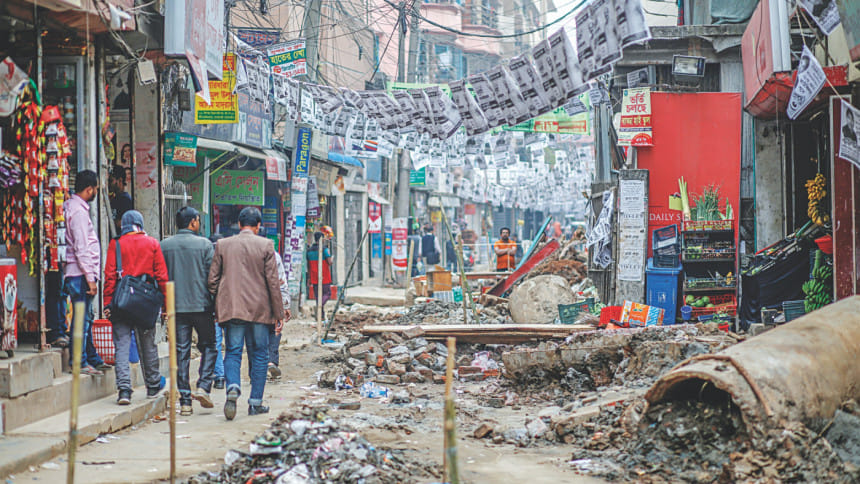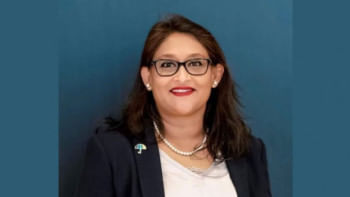City Development: Attention not same for all

A mess only five years ago, the sidewalks in Gulshan-2 residential area now make for a streamlined jogging track, with dips in front of the gates of people’s homes.
Stepping out of a gate, joggers can immediately pick up pace on the smooth pavement below, go all the way up to Banani’s Kemal Ataturk Avenue and return. There will be fine tactile pavings under their feet all the time, except when the joggers will have to cross the Banani Bridge.
One may wonder in how many other areas in the city people can start jogging right in front of their home and cross such a long stretch of pavement without hindrance.

They certainly cannot do so in Khilkhet for instance.
There is no sidewalk from Bastola Road area to Karuna Garments on Lake City Road. There is a pavement from near the factory, but it is so narrow that two people can hardly walk on it side by side.
Despite the fact that these two neighbourhoods are under the same city corporation -- DNCC -- the scenario seems different when it is about infrastructure development.
It appears some areas are more important than others.
Ahead of tomorrow’s city corporation polls, campaign posters have been hung in all the alleys in the capital. Not all roads in the city, however, were given the same treatment.
It raises one question: Isn’t every voter equal?
One might not think so taking a look at the spending by the outgoing city corporations.
THE PUZZLING MATH
The Dhaka north and south city corporations have taken up large government-funded development projects to improve roads, sidewalks, storm drainage, parks and playgrounds.
But whether the corporations would focus on just the main arteries and its immediate connecting roads, or give the facelift to the entire area apparently depends on the average income of the people living there, documents suggest.
Areas in Gulshan, Banani, and Baridhara were shaped up under a Tk 70 crore project since 2015-2016. City corporation officials call it late mayor Annisul Huq’s capstone project and a model to be imitated in other city areas.
Uttara residential area has got a similar treatment for Tk 85.9 crores, since 2015, shows documents of Dhaka North City Corporation (DNCC).
Even though Khilkhet is situated near the city’s main thoroughfares, such development work never seemed a priority.
As per DNCC budget documents, the area stretches over 15sqkm but facelift work is going on on three roads.
A quick scan of the real estate websites suggests property prices in Uttara and Gulshan are approximately three and five times higher than that of Khilkhet.
Mirpur is another area where the DNCC spent money on such work even though the area isn’t stereotypically well-off.
Mirpur is a vast area consisting of seven wards, and flat prices varying from Tk 19 lakh to Tk 2 crore.
City corporation officials, however, say that road improvements were done there keeping in mind it will be the starting point of the first metro rail line, making it one of the best connected areas in the city in the near future.
“The entirety of the locality got a thorough facelift worth around Tk 700 crores, with nearly all roads covered, and no stone left unturned. We worked on building sidewalks and drains, in addition to roads,” stated Faruk Hasan Md Al Masud, deputy project director of an infrastructure project.
This makes Mirpur the area where the DNCC spent the most money.
Overall, the DNCC has undertaken over a thousand crores’ worth of government-funded projects to improve city streets. A majority of this went into Mirpur and adjacent areas, Gulshan, Banani, Baridhara, and Uttara, leaving a minor share for Rampura, Khilkhet, Joar Sahara, Kalachandpur, Jagannathpur, Kawran Bazar, Mohammadpur, Kafrul, and Shyamoli.
Many DNCC areas were left out altogether.
Meanwhile, the Dhaka South City Corporation (DSCC) has not undertaken any projects on the same scale as the DNCC. Their total expenditure comes to an approximate figure of Tk 300 crores over the last five years, according to budget documents.
DSCC officials refused to confirm the exact figure, despite repeated attempts by this correspondent.
“The city corporation worked on roads in Doyaganj, and are currently repairing sidewalks, drains, and roads in Shahjahanpur, Banasree, Meradia, Lalbagh, Kamrangirchar, and Shahidnagar,” said DSCC’s public relations officer, Uttam Kumar Roy.
SOME MORE EQUAL THAN OTHERS
In addition to fixing the roads, the DNCC is also working to upgrade 20 parks and playgrounds. Nine of these are in Gulshan, Banani, and Baridhara areas.
The rest are near Town Hall, Tajmahal Road, Humayun Road and Iqbal Road in Mohammadpur areas, and one each from Rayerbazar, Shyamoli, Moghbazar and Kawran Bazar areas.
This still deprives the residents in DNCC areas of new and improved parks. In fact, the city corporation does not hold data on what other parks and public spaces there are out there, officials said.
By DNCC’s own statistics, only 25 percent of its households are in areas where these new parks are located, or in areas adjacent to the parks.
“We had asked the respective owners of parks [like housing societies] to hand over the parks to us. Those that were handed over, we worked on them,” said Tariq Bin Yusuf, executive engineer of a project.
Once completed, the parks promise to be delightful places. As Yusuf explained, “The parks are being fitted with lit walkways so that they are safe at night, children’s zones, security cameras, canteens, public toilets, and more.” Gulshan Central Park, for example, will have a beautiful lake surrounded by a promenade, and floating platforms.
“We hope to take a look at public spaces in Mirpur in the upcoming years,” said Yusuf.
The city corporations have also taken up projects to develop the 36 wards newly added. There are 129 wards under the two city corporations.
EXPERTS’ TAKE
Sultan Hafeez Rahman, eminent governance expert and former executive director of Brac Institute of Governance and Development (BIGD), sees the risk of interference by local-level elites as a barrier to general development processes.
“The appearance of elite influence is pervasive in decision-making processes, which may explain why certain areas are given priority over others,” he stated.
“Given the limitation of resources, the city corporation must prioritise. It also makes sense because Dhaka needs development. The question is, how and where would you begin? It is difficult to understand why certain residential neighbourhoods are being chosen over others.”
Ward meetings between the councilors and constituents need to happen, and in a structured, active manner, he added.
Adil Mohammad Khan, general secretary of Bangladesh Institute of Planners, reiterated the same view, adding that development expenditure should truly reflect the relative needs of a ward.
“There is a discrepancy in how long it takes for a road in a high-income neighbourhood to get fixed compared to one in a low-income neighbourhood,” he stated.
The Daily Star repeatedly tried to contact the CEOs of the city corporations for comments on the spending, but they did not respond to phone calls and text messages.

 For all latest news, follow The Daily Star's Google News channel.
For all latest news, follow The Daily Star's Google News channel. 



Comments